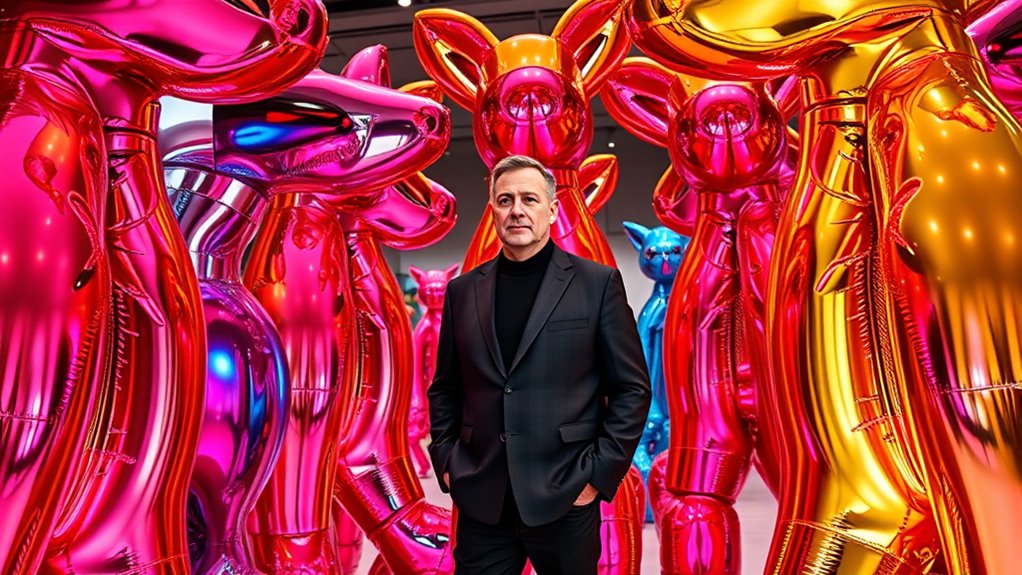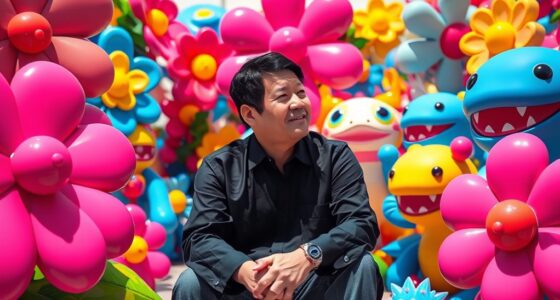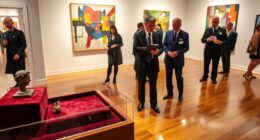Jeff Koons celebrates pop culture by transforming everyday objects and icons into large, shiny sculptures that challenge traditional ideas of art and value. His work blends consumerism, irony, and humor with themes of banality and seduction. Using advanced studio methods and automation, he creates highly detailed pieces that reflect society’s obsession with goods and fame. To discover how his approach reshapes modern art, explore further his innovative techniques and cultural impact.
Key Takeaways
- Koons elevates everyday objects and icons into high art, blending consumer culture with fine art practices.
- His *Celebration* series features vibrant stainless steel sculptures symbolizing joy and festive themes.
- Koons uses glossy surfaces and vivid colors to mimic advertising, engaging viewers emotionally and culturally.
- His work critiques materialism and societal obsession with consumer goods through playful yet provocative sculptures.
- Koons’s integration of pop imagery and mass-produced techniques challenges traditional notions of artistic originality.
The Artistic Origins and Education of Jeff Koons
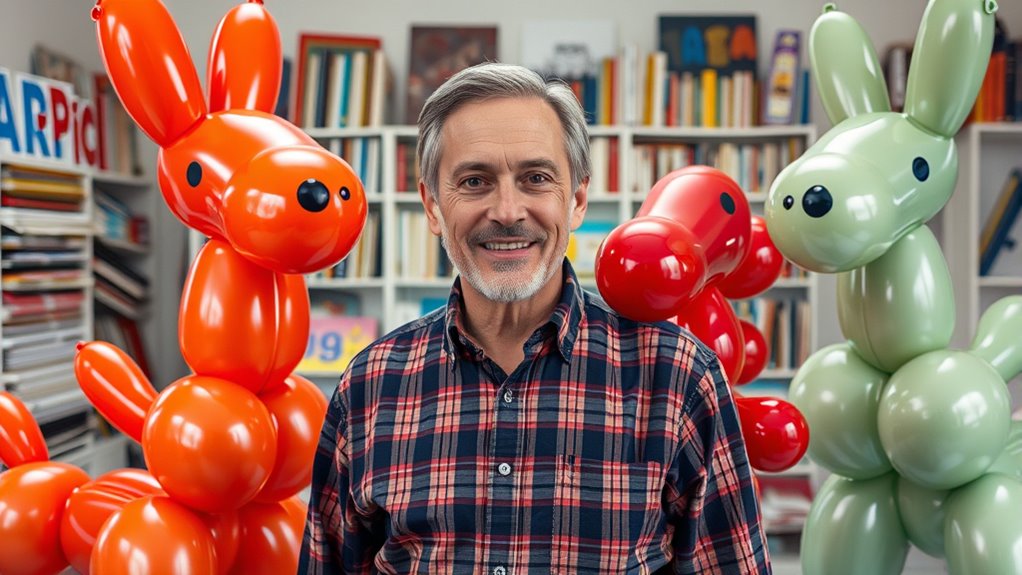
Ever wonder where Jeff Koons’s fascination with pop culture began? It all started in York, Pennsylvania, where he was born in 1955. You might be surprised to learn that his art journey took shape at the Maryland Institute College of Art in Baltimore, where he studied and earned his B.F.A. in 1976. During an exchange year at the School of the Art Institute of Chicago, Koons was exposed to diverse artistic environments that influenced his style. These experiences helped him explore different mediums and techniques, laying the groundwork for his later focus on popular culture themes. His early education and exposure to various art forms fueled his experimental approach, setting the stage for his unique blend of fine art and consumerist imagery. He also visited Salvador Dalí at the St. Regis Hotel in New York City during his teenage years, which further inspired his surreal and provocative artistic vision. Additionally, his engagement with pop art influences played a significant role in shaping his creative perspective. His fascination with consumerist imagery and mass-produced objects became a hallmark of his work, bridging the gap between high art and popular culture. Moreover, his interest in cultural symbolism helped him incorporate deeper meanings into his playful yet thought-provoking pieces. Furthermore, his exposure to contemporary art movements during his education expanded his artistic repertoire and thematic depth.
Embracing Consumerism and Popular Culture in Koons’ Work
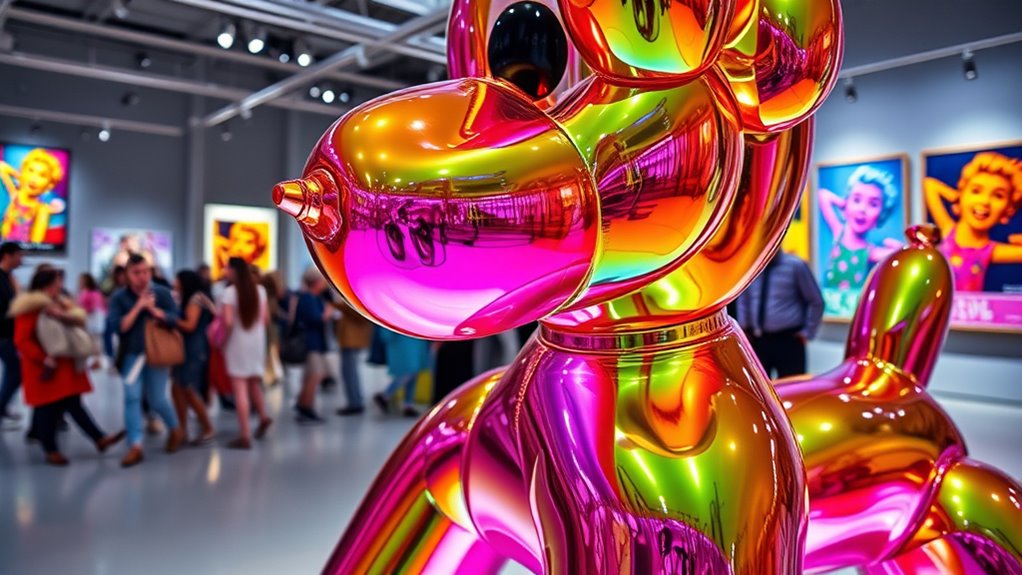
Jeff Koons’ work boldly embraces the themes of consumerism and popular culture, transforming everyday objects into high art. In his “The New” series, vacuum cleaners encased in glass elevate mundane items, blurring the line between shopping and art—making viewers see these objects as symbols of desire and untouched freshness. By displaying identical models in different colors, Koons highlights consumer convergence and the loss of individuality, reflecting how mainstream culture promotes conformity. His art mimics advertising tactics, creating visual spectacle and emotional impact that appeal broadly. Koons’ sculptures serve as artifacts of desire, turning icons like cars and drinks into symbols of want, critiquing how commodification shapes our perceptions and values within a consumer-driven society. His work often employs vivid colors and glossy surfaces to evoke emotional and cultural longing, further emphasizing the influence of consumer culture on individual identity. Additionally, Koons’ use of pop culture symbolism amplifies the message of materialism and societal obsession with consumer goods. Recognizing the importance of artistic commentary in his work helps deepen understanding of how consumerism influences contemporary art and society. Incorporating consumer culture themes into his art underscores how modern society is shaped by pervasive advertising and branding, prompting viewers to reflect on their own consumption habits. Exploring visual language in his pieces reveals how artists communicate complex societal messages through accessible imagery. Moreover, understanding the mass media influence behind consumer culture can provide further insight into the pervasive nature of these themes in Koons’ work.
Iconic Sculptures and Series That Define Koons’ Style
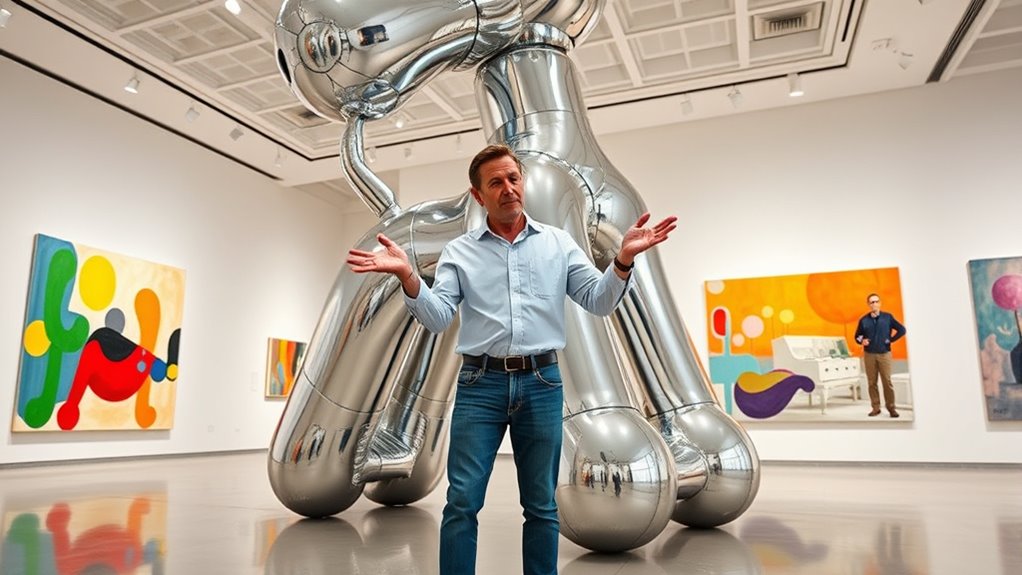
Jeff Koons’ signature stainless steel sculptures transform everyday objects and pop culture icons into monumental works of art. Series like *Rabbit*, *Balloon Dog*, and *Gazing Ball* showcase his mastery of polished surfaces and playful themes. These memorable projects define his distinctive style, blending high craftsmanship with mass appeal. His work often incorporates elements of industrial design, reminiscent of the intricate gear and mechanical motifs found in Steampunk and Victoriana aesthetics.
Signature Stainless Steel Forms
Signature stainless steel forms are the hallmark of Koons’ art, transforming everyday objects into striking, reflective sculptures that captivate viewers. These sculptures reflect their surroundings, inviting interaction and self-reflection. Koons pushes technological boundaries, often spending years perfecting intricate craftsmanship, with stainless steel providing a sleek, mirror-like finish that enhances visual impact. Iconic series like *Rabbit* (1986) and *Balloon Dog* (1994) exemplify his mastery, blending celebration, playfulness, and consumer culture. The *Rabbit* symbolizes the banal and everyday, challenging art’s traditional seriousness, while the *Balloon Dog* embodies joy and childhood simplicity. Koons’ innovative use of materials and technology creates cultural icons that influence contemporary art and market dynamics, cementing his legacy in the celebration of pop culture. Additionally, his works are often associated with pop culture and consumerism, reflecting society’s fascination with mass-produced objects. By incorporating advanced fabrication techniques, Koons ensures his sculptures achieve the desired visual and material quality, setting new standards in contemporary sculpture. Furthermore, his mastery of industrial manufacturing processes allows for the creation of large-scale, highly detailed works that push the boundaries of traditional sculpture.
Memorable Pop Art Series
Among Koons’ most memorable pop art series are those that blend bold scale, vibrant colors, and familiar icons, instantly capturing your attention. The Banality series, launched in 1988, celebrates popular culture with ceramics, porcelain, and painted wood, often featuring animals like in *Michael Jackson and Bubbles*. It explores the intersection of art and everyday life through recognizable icons. The Celebration series, begun in 1994, includes large-scale sculptures like the *Balloon Dog*, made from polished stainless steel in vivid colors, symbolizing joy and merriment. The Statuary series, introduced in 1986, reimagines inflatable objects in stainless steel, showcasing figures inspired by history and art, such as the highly polished *Rabbit*. These series define Koons’ style, blending pop culture references with grand scale and vibrant presentation. Additionally, Koons’ mastery of pinball machine mechanics and design influences his sculptural work, emphasizing the importance of craftsmanship and interactive elements in his art.
Techniques and Studio Practices Behind Koons’ Artworks
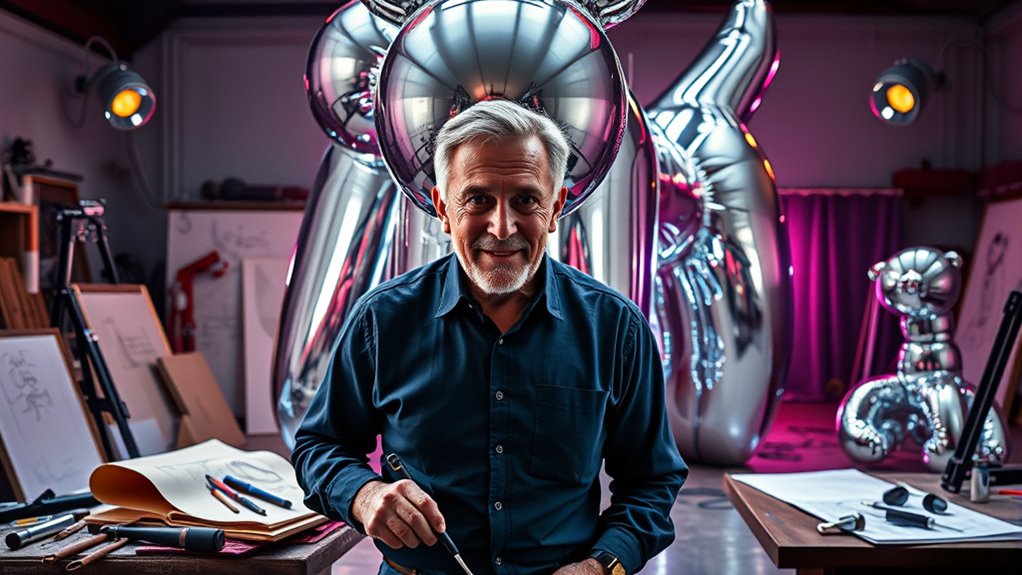
You notice that Koons’ studio operates like a factory, with a large team of assistants handling different tasks. They use advanced digital tools and automation to guarantee precision and consistency across works. This collaborative, tech-driven approach allows Koons to produce large-scale sculptures with intricate details that stay true to his vision. Additionally, employing sound design techniques helps streamline the creative process while maintaining high-quality standards. Incorporating workplace efficiency strategies further enhances productivity and ensures the timely completion of projects. Moreover, the studio’s adherence to legal and safety standards ensures a secure environment that supports sustained creative output. The use of advanced manufacturing processes enables the studio to achieve the complex finishes and textures characteristic of Koons’ iconic works.
Assistants and Factory Workflow
Jeff Koons relies heavily on a team of studio assistants who execute his designs with strict adherence to detailed instructions, often working in a factory-like environment. You’ll find assistants skilled in various mediums such as painting, sculpture, photography, and drawing, all following precise guidelines without creative deviations. The workflow is highly structured, with assistants using methods like paint-by-numbers to reproduce large images accurately. In the studio, a hierarchy ensures Koons’ vision remains central, with assistants acting as extensions of his creative process. Over time, staff reductions and studio relocations have reshaped operations, but the core remains focused on meticulous execution. This systematic approach allows Koons to produce large-scale works efficiently, emphasizing the importance of teamwork and disciplined craftsmanship in his art. Additionally, the studio environment is meticulously organized to maintain consistency and quality across all pieces.
Automation and Digital Tools
Digital tools play a crucial role in shaping the precision and efficiency of Koons’ studio practices. You use CAT scan technology to digitally map every detail of objects, ensuring accurate sculpting. Collaborating with experts from MIT’s Center for Bits and Atoms helps tackle complex projects, pushing boundaries. Though Koons may not directly use 3D printing, similar digital techniques, like digital prototypes and computer-assisted design, optimize planning and visualization before fabrication. In sculpture, digital data guides machine carving and milling, enabling precise marble work and large-scale pieces. For painting, digital image analysis and software help create accurate collages, scales, and color mixes. Automation speeds up production, improves accuracy, and allows for ambitious, large artworks, but some projects still require years of meticulous digital and manual effort.
The Thematic Focus on Banality and Seduction
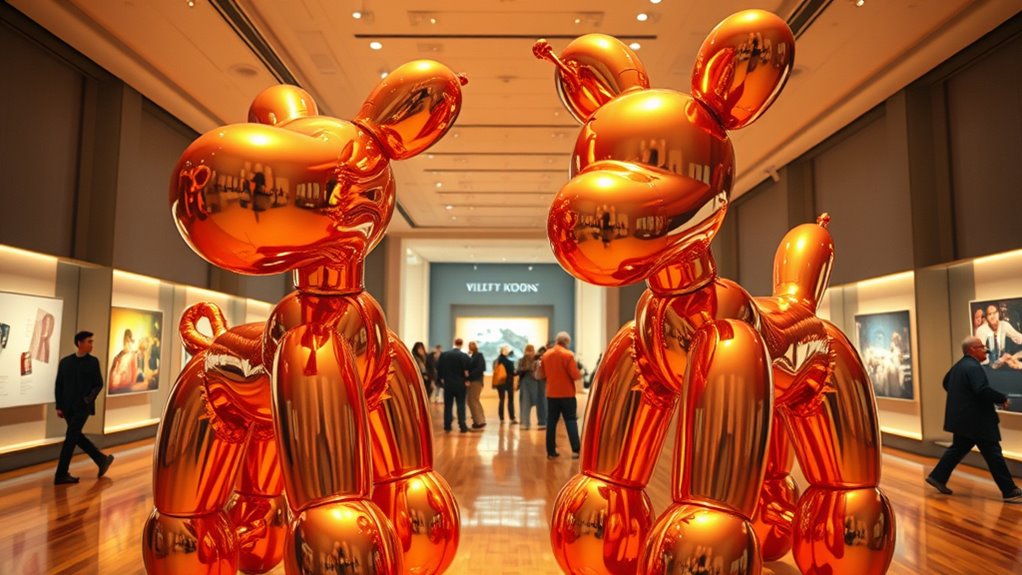
Thematic focus on banality and seduction reveals how Koons transforms everyday objects and cultural icons into provocative art that challenges traditional notions of value and beauty. With his Banality series, launched in 1988, you see this clearly—celebrating popular culture through ceramics, porcelain, and painted wood. Works like “Michael Jackson and Bubbles” feature familiar icons, turning them into playful, yet critical reflections on suburban life and consumerism. Koons uses banality to poke fun at the ordinary and critique modern culture driven by commerce. Seduction appears in his work by blending humor, eroticism, and irony, often referencing celebrities and societal norms. These themes provoke debate, questioning what society considers desirable or valuable, ultimately forcing you to reconsider the relationship between art, pop culture, and societal values.
The Evolution of Koons’ Studio and Production Methods

Koons’ studio has evolved considerably from its origins as a small, loft-based workshop in SoHo to a large-scale, industrial operation. Initially, you’d find over 30 assistants working in a space modeled after Warhol’s Factory, with tasks divided among specialists. As the studio expanded to Chelsea, it grew to support up to 120 workers across 16,000 square feet, enabling the simultaneous production of iconic sculptures like Balloon Dog. You’ll notice a shift toward integrating advanced technology, including digital mapping, computer-generated collages, and precise machinery for carving and finishing. Koons now emphasizes digital design, automation, and specialized training, streamlining production. Post-2019, the studio downsized but relies even more on digital tools and automation, ensuring consistent quality with a smaller, more efficient team.
The Lasting Influence and Cultural Significance of Koons’ Art

Jeff Koons has profoundly shaped contemporary art by blending consumer culture with fine art, challenging traditional boundaries and expectations. His work redefines the line between high art and mass culture by integrating everyday objects and kitsch imagery into gallery settings. You see his influence in pioneering unconventional materials and finishes, inspiring future artists in sculpture and installation. His art questions value, spectacle, and commodification, sparking debates on originality and the legacy of Duchamp’s readymades in today’s consumer-driven society. Recognized globally, major museums like the Guggenheim and MoMA hold his works, and his iconic pieces, such as “Balloon Dog,” reach high-profile audiences. His provocative commentary on taste, celebrity, and commercialism continues to influence academic discourse and market dynamics.
Jeff Koons blurs high art and consumer culture, challenging norms and inspiring debates on value, spectacle, and artistic originality.
- Redefined boundaries between high art and mass culture
- Inspired new approaches with unconventional materials
- Shaped debates on value, spectacle, and commodification
- Secured institutional recognition with major acquisitions
- Provokes ongoing conversations on taste and artistic integrity
Frequently Asked Questions
How Does Koons Choose the Objects He Elevates in His Sculptures?
You notice that the objects chosen for art are everyday, familiar items like toys or household objects. These selections are made because they evoke nostalgia, joy, or wonder, and their simple forms are easily transformed through artistic techniques. You see that Koons aims to elevate mundane objects by highlighting their overlooked beauty, making them icons of pop culture and challenging ideas about value and artistic worth.
What Role Do Assistants Play in Creating Koons’ Artworks?
You might wonder about the role assistants play in creating artworks. They follow the artist’s precise instructions, handling labor-intensive tasks like sculpting, painting, and fabricating. Using advanced tools and techniques, they replicate detailed designs under strict guidance. While they do the physical work, the artist maintains control and sees the final piece as their own. Their contributions are essential but often go unrecognized, functioning as extensions of the artist’s vision.
How Does Koons’ Work Challenge Traditional Notions of Art and Craftsmanship?
You might think traditional craftsmanship defines art’s value, but Koons challenges that idea. His work blurs the line between high art and mass-produced objects, elevating mundane items with luxurious materials and meticulous techniques. By doing so, he questions what truly constitutes craftsmanship, emphasizing concept over tradition. This approach pushes boundaries, transforming ordinary objects into provocative artworks that challenge conventional notions of beauty, skill, and artistic legitimacy.
In What Ways Has Koons’ Art Influenced Contemporary Pop Culture?
Your work influences contemporary pop culture by blending everyday objects with high art, making art more accessible and relatable. You challenge perceptions by elevating kitsch and consumer products, prompting society to rethink value and taste. Your use of familiar imagery from toys, advertising, and childhood evokes nostalgia, shaping trends and inspiring other artists. This fusion of commerce and creativity impacts how popular culture is created, consumed, and appreciated today.
How Does Koons’ Use of Bright Colors Affect Viewer Perception?
You notice that bright colors in art grab your attention instantly and evoke strong emotions. They create a lively, energetic feel, making the artwork seem playful or exciting. Contrasting hues add movement and focus your gaze on specific details. Bright, bold colors also make the piece more accessible and familiar, encouraging you to connect emotionally and engage deeply, as the colors stimulate your senses and influence your mood.
Conclusion
As you step back and take it all in, Jeff Koons’ work truly captures the spirit of pop culture, turning everyday objects into art that’s larger than life. His approach shows you can turn the mundane into something extraordinary, proving that art and consumerism are two sides of the same coin. Koons reminds you that sometimes, you have to think outside the box to see the beauty in the commonplace.

